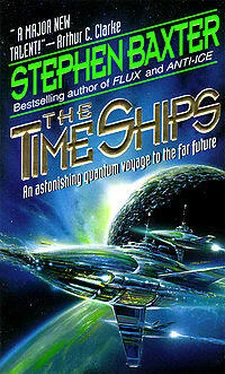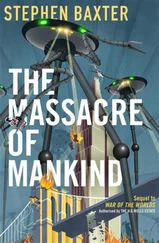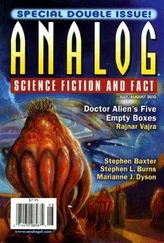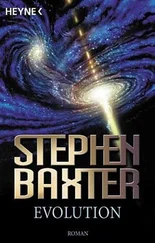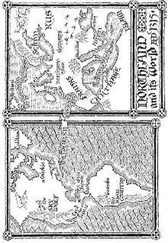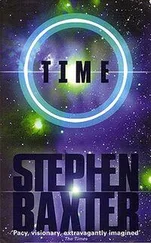I pulled at my chin. I wondered how much I would have seen of the worlds I had visited if I had peered at them anxiously from within such an armored Time-Car as this!
“Plattnerite is essential, of course,” Wallis went on, “but we don’t think there’s any need to go doping components of the machine with the stuff, as you did. Instead, it should be sufficient to fill up these flasks with the raw stuff:” He unscrewed a cap from one of the corner units to show me. “See? And then the thing can be steered through time, if steer is the right verb, from within the cabin.”
“And have you tried it out?”
He ran his fingers through his hair, making a lot of it stand on end. “Of course not! — for we have no Plattnerite.” He clapped me on the shoulder. “Which is where you come in.”
Wallis took me to another part of the complex. After more security checks we entered a long, narrow chamber, like a corridor. This chamber had one wall made entirely of glass, and beyond the glass I could see into a larger room, about the size of a tennis court. That larger room was empty. In our narrower companion chamber there were six or seven researchers sitting at desks; each wore the characteristic dirty white coat into which every experimentalist seems born, and they hunched over dials and switches. The researchers looked around at me as we entered — three of them were women — and I was struck by their drawn faces; there was a sort of nervous fatigue about them, despite their apparent youth. One class of instrument kept up a soft clicking, the whole time we were there; this was the sound of “radiation counters,” Wallis told me.
The larger chamber beyond the glass was a simple box of concrete, with unpainted walls. Though quite empty, a monolith of bricks perhaps ten feet tall and six wide stood, square and silent, at the chamber’s center. The bricks were of two sorts, light and dark gray, alternating in a neat pattern. This monolith was held up from the floor on a layer of thicker slabs, and wires trailed from it to sealed orifices in the walls of the room.
Wallis stared through the glass. “Remarkable — isn’t it? — that something so ugly, so simple, should have such profound implications. We should be safe here — the glass is leaded — and besides, the reaction is subdued at present.”
I recognized the heap from the Babble Machine show. “This is your fission machine?”
“It is the world’s second Graphite Reactor,” Wallis said. “It’s pretty much a copy of the first, which Fermi built at the University of Chicago.” He smiled. “He put it up in a squash court, I understand. It’s a remarkable story.”
“Yes,” I said, becoming irritated, “but what is Reacting with what?”
“Ah,” he said, and he took off his spectacles and polished the lenses on the end of his tie. “I’ll try to explain…”
Needless to say, he took some time about this, but I managed to distill the essence of it for my understanding.
I had already learned from Nebogipfel that there is a substructure within the atom — and that Thomson would take one of the first steps to this understanding. Now I learned that this substructure can be changed. This may happen through a coalescing of one atomic core with another, or perhaps spontaneously, through the breaking-up of a massive atom; and this disintegration is called atomic fission.
And, since the sub-structure determines the identity of the atom, the result of such changes is nothing less, of course, than the transmutation of one element into another — the ancient dream of the Alchemists!
“Now,” said Wallis, “you won’t be surprised to learn that on each atomic disintegration, some energy is released — for the atoms are always seeking a more stable, lower energy state. Do you follow?”
“Of course.”
“So, in this pile, we have six tons of Carolinum, fifty tons of uranium oxide, and four hundred tons of graphite blocks… and it is producing a flood of invisible energy, even as we look at it.”
“Carolinum? I have not heard of that.”
“It is a new, artificial element, produced by bombardment. Its half period is seventeen days — that is, it loses half its store of energy in that period.”
I looked again at that nondescript heap of bricks: it looked so plain, so unprepossessing! — and yet, I thought, if what Wallis said about the energy of the atomic core was true…
“What are the applications of this energy?”
He popped his glasses back onto his nose. “We see three broad areas. First, the provision of energy from a compact source: with such a pile aboard, we can envisage submarine Juggernauts which could spend months below the ocean, without the need to refuel; or we could build high-altitude Bombers which could circle the earth dozens of times before having to land — and so forth.
“Second, we’re using the pile to irradiate materials. We can use the byproducts of uranium fission to transmute other materials — in fact, a number of samples are being run in there for Professor Gödel just now, to support some obscure experiment of his. You can’t see them, of course — the sample bottles are within the pile itself…”
“And the third application?”
“Ah,” he said, and once more his eyes took on that remote, calculating look.
“I see it already,” I said grimly. “This atomic energy would make a fine Bomb.”
“Of course there are severe practical problems to solve,” he said. “The production of the right isotopes in sufficient quantities… the timing of preliminary explosions… but, yes; it looks as if one could make a Bomb powerful enough to flatten a city — Dome and all — a Bomb small enough to fit into a suitcase.”
We set off through more of the narrow concrete corridors, emerging at last in the College’s main office block. We came to a corridor carpeted in plush pile, with portraits of eminent men of the past on the walls — you know the sort of place: a Mausoleum for Dead Scientists! There were soldiers about, but they were discreet in their presence.
It was here that Kurt Gödel had been awarded an office.
With quick, efficient strokes, Wallis sketched out Gödel’s life for me. He was born in Austria, and took his degree, in mathematics, in Vienna. Influenced by the gaggle of Logical Positivist Thinkers he found there (I have never had much time for Philosophizing myself), Gödel’s interests drifted towards logic and the foundations of mathematics.
By 1931 — he was just twenty-five — Gödel had published his startling thesis on the eternal Incompleteness of Mathematics.
Later, he showed interest in the physicists’ newly emerging studies of Space and Time, and he produced speculative papers on the possibility of time travel. (These must have been the published studies to which Nebogipfel had referred, I thought.) Soon, under pressure from the Reich, he was moved to Berlin, where he began work on the military applications of time traveling.
We reached a door on which a brass plate bearing Gödel’s name had been fixed — so recently, in fact, that I spotted spindles of wood from the drilling on the carpet below.
Wallis warned me that I could have only a few minutes on this visit. He knocked on the door.
A thin, high, voice within called: “Come!”
We entered a roomy office with a high ceiling, fine carpet and rich wallpaper, and a desk inlaid with green leather. Once this room must have been sunny, I realized, for the wide windows — now curtained — faced westwards: in fact, in the direction of the Terrace where I was lodged.
The man at the desk continued to write as we entered; he kept his arm tucked around the page, evidently lest we see. He was a short, thin, sickly-looking man, with a high, fragile forehead; his suit was of wool and quite crumpled. He was in his thirties, I judged.
Читать дальше
Конец ознакомительного отрывка
Купить книгу
